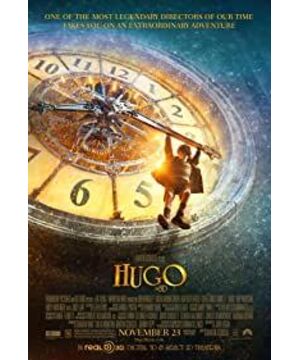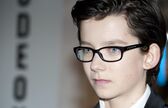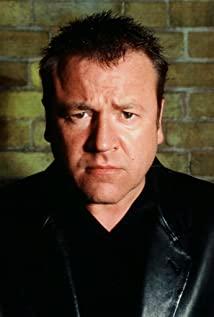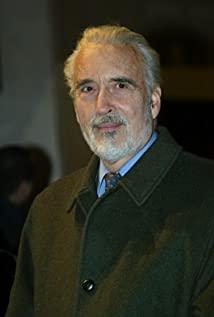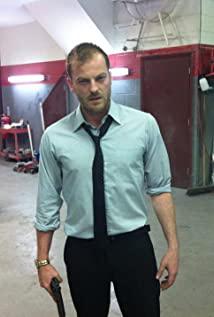I was in Paris last year and passed by Montparnasse station several times. I can no longer see the style before the renovation in the 1960s. In 1895, there was a train derailment here. Meet again at this station, in Martin Scorsese's first 3D movie "Hugo" (Hugo, 2011); the train accident also reappears in the dream of the protagonist, 12-year-old orphan Hugo. The film is adapted from Brian Selznick's "The Invention of Hugo Cabret" (The Invention of Hugo Cabret, 2007) that won the Caldecott Medal for American children's book. Bryan has a long history with movies. This book was influenced by the French director Rene Claire's film "Under the Eaves of Paris" (1930); he is often proud to see his surname appearing at the beginning and end of the movie in the theater-cousin David Sey Erznik was a famous Hollywood producer. His important works include "King Kong" (1933) and "Gone with the Wind" (1939). "Hugo" screenwriter John Logan (John Logan), worked with Scorsese in "Aviator" (2004). The film's narrative clues and key points are diverse, overlapping, and shifting. In Paris in 1931, the boy Hugo lived alone and secretly in the public space of Montparnasse station (to avoid being sent to the orphanage by the police), such as the children's version of "Notre Dame de Paris" and "The Phantom of the Opera". Traces of Dickens' novel "Orphan in the Fog" or "Great Expectations". Hugo's watchmaker father was killed in the fire, and his uncle, who managed the station clock time, drank and disappeared. Hugo, who is proficient in clock and watch mechanics, took on the responsibility of his uncle and tried to repair the robot his father brought back from the museum-this is the only connection between him and his father and the good life in the past, and he believes that a robot that can write will bring him Message from my father. Hugo stole some parts from the toy store from time to time, and was severely punished by the grumpy store owner George. Hugo therefore got to know George’s adopted daughter, Isabelle, an orphan of the same age, and explored with her the secrets of the robot and George. This adventure leads to the important founder of early movies, Georges Méliès (1861-1938), and A precious history of silent film.
At the moment when traditional film movies encounter the impact of digital technology and film scholars exclaimed that "movie is dead", Scorsese pays tribute to the glorious past of traditional movies with fashionable digital 3D and computer special effects, which is meaningful. The huge US$170 million "Hugo" was released in the United States during the "Thanksgiving" holiday, and the critics responded well. Cameron's "Avatar" (Avatar) is almost a "watershed" meaning, making American film critics refer to the subsequent 3D film period as the "post-Avatar era". Not only are well-known Hollywood directors eager to try 3D technology (Spielberg's 3D animation "The Adventures of Tintin" will be released in the United States), previous blockbuster films such as "The Lion King" and "Titanic" are also re-released in 3D versions. In addition to commercial considerations (adding 3D condiments and then fried rice, and the price of 3D movies is higher), this 3D trend is that movies respond to other media challenges (such as TV, the Internet, games, "small screen movies", etc.), and strive for a new generation of audiences. The cinema’s initiatives include multiple technological changes in sound, color, widescreen, and stereo in the film history of more than a century. Some commentators believe that 3D movies may be just like the 1950s, but they are just a fad—although there have been significant advancements in technology. The three-dimensional simulation of 3D movies only brings more sensory stimulation, and makes the audience more "baby", without bringing brain and thinking shocks, such as "storm in a water glass", which is wrapped in crystals. Of course, how to use 3D technology as imaginatively and creatively as possible and give full play to its visual expertise is a question that directors and critics are thinking and arguing about. "Hugo" received praise, precisely because of Scorsese and the creative team's skillful and sophisticated, amazing visual creativity and expressive power.
Many critics considered "Hugo" to be Scorsese's "visually outstanding film". The film cost a lot of money. It was set up in the Shepperton studio outside London to set up a highly simulated 1930s French Montparnasse station. It is tall and wide, with meticulous details and meticulous design. The actors roam in it when they are resting, making the performance state stay in the magical world of Paris. In addition to the fantastic ideas of art director Dante Ferretti, photographer Robert Richardson flexibly shuttles through this difficult, multi-detailed sports photography long lens that is full of crowds and machine parts. People were surprised and surprised. The Irish writer James Joyce and the jazz musician Django Reinhardt (Django Reinhardt) were visible in the crowd. The three-dimensional sense of scenes, colors, and photography does not conceal the "artificial nature" and fantasy colors, just like the original novel. The relationship between film recording, digital reconstruction and reality reproduction is true and false. Some camera movements are digital production, and there is no real camera entity, and the crowd is also the result of digital production, a kind of ghost-like intangible existence. This will affect our reconsideration of the "realism" of film images.
Scorsese, the 69-year-old director, made his first "child/family film", and there is no such thing as "Taxi Driver", "Poor Streets", "Angry Bull", "New York Gangs", "Infernal Affairs", etc. The bloody violence of the male hormonal breath, but also about the injured and the forgotten film history, may be a little serious, sad, complicated and long for children (or as Scorsese said, he tried to start from the age of 12). A daughter’s perspective to observe the world and interpret stories is more suitable for audiences 12 years old or older). The film has no formal media, mixed genres, with thrilling suspense (despite the clichés of mystery), melodramas, romantic dramas, and chasing farce. Scorsese painstakingly, "borrowing things to express his will", trying to convey his love and fascination with film and film history to young audiences in "children's film" icing, "grab it from the baby". Without their interest and support, the movie would cease to exist. No wonder several reviewers referred to this film as the love story between Scorsese and the movie, and the love letter he wrote to the movie. Therefore, it has become a movie with very personal feelings and colors. Scorsese suffered from asthma when he was young, and he could not go out to play with his peers. He could only sit in an apartment in "Little Italy" in New York and watch old movies on TV, or hide behind the window to watch the market like Hugo: Watch the illusory world in the movie, observe/peep around the world. The first film about film and filmmaking that influenced him was "The Magic Box" (1952) by British director John Boulting (John Boulting). Like Hugo, he rediscovered Mérieux, unearthed the almost forgotten British director Michael Powell and his "Peeping Tom", and established the non-profit organization "World Film Foundation" (World Film Foundation). Cinema Foundation) funded the restoration of old movies. And Powell's widow Thelma Schoonmaker (Thelma Schoonmaker) is Scorsese's long-term co-editor. Scorsese rebuilt Mérieux’s "Dream" glass house studio (the world’s first studio) in "Hugo" and his filming of "Travel to the Moon" scene, and appeared briefly like Hitchcock. On the screen, guest starred as a photographer.
"Hugo" also conveys important topics about modern society and "modernity" in the 1920s and 1930s, namely, the excitement and danger brought by the speed of trains, the contradictory relationship between machines and people (human beings both enjoy the machine belt The convenience of coming, and the fear of being alienated by machines), the meaning of time/clocks in urban life (as a symbol of modern capitalist production and lifestyle discipline, controlling work and leisure time, and also involving urban space and social class composition). These themes and images continued to appear in dramas or "Urban Symphony" movies at the time. The train scenes are reminiscent of French Abel Gonce's "Wheel" (1923), Jean Renoir's "Beast in the Crest" (1938); machines and For robots, there are Frieze Lang's "Metropolis" (1927) in Germany and Chaplin's "Modern Times" (1936) in the United States; time and clocks are "Berlin, Metropolitan Symphony" by Walter Rutmann, Germany. (1927), "The Man with a Camera" (1929) by Soviet Union Jiga Vertov, etc. At that time, there were also films in China that highlighted the image of "clocks and watches" and were more socially critical, such as Shen Xiling's "Shanghai Twenty-Four Hours" (1933) and Cai Chusheng's "New Women" (1935). Watchmakers, magicians and film directors share some commonalities, collaborate precisely, and create illusions. Film may stop time, and time/clock is the real enemy of film (especially in the film age): it corrodes and destroys celluloid and changes the audience's taste. Time is merciless to old movies, and 80 to 90% of the movies in the silent era have disappeared. When "sensitive and fragile" film films are gradually replaced by indifferent and hard digital films, they also lose their short-lived and unstable beauty and sense of imperfection, without ambiguity and sensibility, temperature and softness, and gain immortality in the cold.
"Hugo" shines in the audiovisual style, but the narrative is somewhat far-fetched and mechanical, and emotional expression is superficial and obscured by technology. Some commentators said that “the portraits of the characters under the glass cover are more symbolic than true feelings, and pain and fear are only elements in the environment”. Another interesting point is that in films aimed at American audiences, French culture is equivalent to English dialogue with an exotic atmosphere and a British accent. But regardless of Europe and the United States, in the past one or two years, "films about movies" have continued to appear, becoming a trend of "finding the roots of movies" or "film archeology", such as Sylvia Chomay's animated film "Magician" about Jacques Tati. (2010), Michael Hazanavicius's "The Artist" (The Artist) on silent film stars, and Simon Curtis's "My Week with Marilyn" (My Week) with Marilyn). Just as "Song in the Rain" looks back at the early days of sound films in the color and sound era, in the era of digital cinema, film encounters this kind of conscious "reflexivity", thinking about film history, film technology and tradition itself, not without nostalgia, implying the past and the The dimension of the future also disturbs the "pantheon" of the movie.
View more about Hugo reviews


